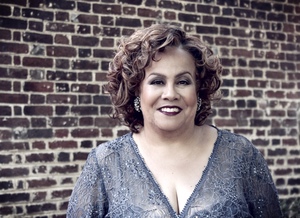Ardent, funny, tough and beautiful. That is what you might say if you had to sum up with a single word each of the four dances performed by the Paul Taylor Dance Company in Page Auditorium on June 8, the opening night of the American Dance Festival’s 29th year in Durham. Or you might say: joyous, sly, ominous and sublime; or, soul-lifting, silly, visceral and sparkling. All would be correct, and none would be adequate to describe these dances by the man often called the greatest living choreographer and performed by his virtuosic company.
Not only is Taylor a choreographer, he is a superb showman, and this evening was another example of his skill at putting together a satisfying program. As is frequently the case, it was designed like a well made sandwich: two barefoot ballets on the outside, a piquant relish and a big chewy piece of meat on the inside.
The meat in this program is 2005’s Banquet of Vultures, danced to Morton Feldman’s Oboe and Orchestra under Jennifer Tipton’s harsh and confusing lighting. It is not a work to make you forget your fears but to make you face a particular set of them. It is about war, and the masters of war, about the armies and whether they control the narrative or are the tools of The Suit. Several things about it are reminiscent of 2004’s Le Grand Puppetier, but Banquet of Vultures is a far darker and more ominous vision. Michael Trusnovec exercises a hypnotic power as The Suit, moving with terrifying authority through the writhing army (clad in camo jumpsuits, heads wrapped and masked like terrorist thugs). The work is so visceral and upsetting that I found myself flinching and shaking, and only later, in my mind’s eye, did I see just how demanding the choreography is for the male lead, and just how stunning Trusnovec’s performance was. The most interesting thing about Banquet, though, is its look at the balance of power and its finding of the edge between defense and endangerment, between surveillance and spying, between attacking and being attacked.
The piquant sauce to this meat was new this year. Troilus and Cressida (reduced), set to Amilcare Ponchielli’s frothy “Dance of the Hours,” is a send-up of dance and a certain strain of high culture generally. Like other Taylor burlesques, it is tastefully gaudy, replete with candy colors and broad caricatures. Cressida was danced by Lisa Viola, who is very, very funny, and Robert Kleinendorst’s Troilus was the perfect combination of wimp and buffoon. But this piece wasn’t just to amuse us. It was cleverly inserted before Banquet of Vultures to lull us with easy pleasure, and its marzipan qualities brought the bitterness of the succeeding Banquet to full depth.
The aspect of Taylor’s extraordinarily wide-ranging creativity that I value most — more than his humor, more than his trenchant analyses of society and power — is his ability to make beauty, and to make it with such musicality that it seems that the music itself has generated the movement. The lovely dance Aureole (1962) which opened the program exemplifies this, and seeing it again was like feeling the first rain after a long drought. Set to excerpts from Handel’s Concerti Grossi in C and F, and from his Jephtha, the dance embodies both the intricate and the broad qualities of the music. Five dancers all in white frolic through little cat steps and jumps and, in other sections, reach and swirl with the broadest of baroque gestures. All were excellent, especially the amazing, elastic, Richard Chen See, and Orion Duckstein, whose long limbs draw wonderful lines in the space. The diagonals of traveling jumps zipping across the stage and linking these disparate sections are so lovely that a rush of exhilaration splits open the heart’s old scars and frees it to accept the salve of joy.
My heart was all the more ready for beauty and its joys after eating crow with the vultures. The program’s final work, Cascade (1999), was danced ravishingly by the company, including Heather Berest, a NC School of the Arts graduate who is completing her final year of touring with the Paul Taylor Company. Also particularly notable were Lisa Viola, Richard Chen See, and in the Andante of Concerto No. 7, the fabulous Annamaria Mazzini and the awesome Michael Trusnovec.
Set to selections from J.S. Bach’s concerti nos. 4, 5, and 7 for piano and orchestra, Cascade felt as good to this viewer as skipping through sunlight by a free-running river in a deep forest — the Forest of Arden, perhaps. Images coalesce in the sparkling light, only to evanesce in the dappled shade. The fleet dancers, their rich supple garments toned to earth and plants and glistening like wetted fur, scissor and flash across the stage like herds of bold deer leaping from their drinking pools to bound through the river, each footfall marked by a quickly vanishing splash. The mathematical harmony of Bach’s music sparkles on, images bubbling up in the cascade, passing by in the liquid flow of notes. Each has its kinetic, evanescent moment — vanishing from the stage only to coalesce again in the mind’s longing eye. Cascade is a very nearly perfect dance — not a statement, not a piece of performance art, not a magic ritual — and as such, it reminds us very sweetly that to dance is to live.











